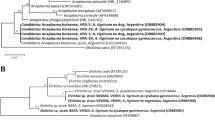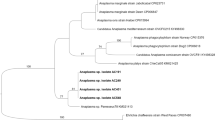Abstract
Adults and nymphs of Amblyomma exornatum, A. flavomaculatum, A. latum, Amblyomma spp. and Hyalomma aegyptium, were collected from savannah monitors, royal python (Africa, Ghana) and marginated tortoises (Europe, Greece) imported to Poland, in 2004–2007. Altogether 345 ticks were examined by polymerase chain reaction for rickettsial agents. None of the tested ticks was positive for the gltA gene of Rickettsia spp. DNA of 16S rRNA gene from Anaplasma phagocytophilum was amplified and sequenced from two adult A. flavomaculatum ticks attached to two different specimens Varanus exanthematicus from Ghana. Both PCR amplicons obtained (GQ305134) had 100% sequence homology with A. phagocytophilum sequences deposited in GenBank. This results suggests for the first time that A. flavomaculatum may be vector of this pathogen in Africa. It could be expected that ticks distributed on their hosts may introduce pathogens not yet known to Polish or even European fauna. This study contributes to the overall recognition of the scarcely explored fauna of the exotic ticks transferred to Poland on reptiles from remote destinations.
Similar content being viewed by others
References
Bodaan C, Nijhoff AM, Postigo M, Nieuwenhuijs H, Opsteegh M, Franssen L, Jebbink F, Jansen S, Jongejan F (2007) Teken en door overdraagbare pathogenen bij gezelschapsdieren in Nederland. Tijdschr Diergeneeskd 132(13):517–523
Burridge MJ (2001) Ticks (Acari: Ixodidae) spread by the international trade in reptiles and their potential roles in dissemination of diseases. Bull Entomol Res 91:3–23
Burridge MJ, Simmons LA (2003) Exotic ticks introduced into the United States on imported reptiles from 1962 to 2001 and their potential roles in international dissemination of diseases. Vet Parasitol 113:289–320
Daszak P, Ball SJ (2001) A description of two new species of coccidia (Apicomplexa: Eimeriidae) from Africa reptiles with nomenclatural corrections for two Caryospora and one Eimeria species from snake. Folia Parasitol 48:1–6
Elbl A, Anastos G (1966) Ixodid ticks (Acarina: Ixodidae) of Central Africa. Volume IV. Genera Aponomma Neumann, 1899, Boophilus Curtice, 1891, Dermacentor Koch, 1844, Haemaphysalis Koch, 1844, Hyalomma Koch, 1844 and Rhipicentor Nuttal and Warburton, 1908. Lists and bibliography. Musee Royal De L’Afrique Centrale—Tervuren, Belgique Annales Sciences Zoologiques Série 8
Gonzalez-Acuna D, Beldomenico PM, Venzal JM, Fabry M, Keirans JE, Guglielmone AA (2005) Reptile trade and the risk of exotic tick introductions into southern South American countries. Exp Appl Acarol 35(4):335–339
Grzeszczuk A, Stańczak J, Kubica-Biernat B (2002) Serological and molecular evidence of human granulocytic ehrlichiosis focus in the Białowieża Primeval Forest (Puszcza Białowieska), north-eastern Poland. Eur J Clin Microbiol Infect Dis 21:6
Holden K, Boothby JT, Anand S, Massung RF (2003) Detection of Borrelia burgdorferi, Ehrlichia chaffeensis, Anaplasma phagocytophilum in ticks (Acari: Ixodae) from a coastal region of California. J Med Entomol 40:534–539
Hoogstraal H (1956) African Ixodoidea. I Ticks of the Sudan (with special reference to Equatoria Province and with preliminary reviews of the genera Boophilus, Margaropus and Hyalomma). Dep Navy Bur Med Surg, Washington
Inokuma H, Oyamada M, Kelly PJ, Jacobson LA, Fourier PE, Itamoto K, Okuda M, Brouqui P (2005) Molecular detection of a new Anaplasma species closely related to Anaplasma phagocytophilum in canine blood from South Africa. J Clin Microbiol 43(6):2934–2937
Institute of Nature Conservation, Polish Academy of Sciences, Kraków, www.iop.krakow.pl/ias
Kauffman TS (1972) A revision of the genus Aponomma Neuman, 1899 (Acarina: Ixodidae). Dissertation, University of Maryland
Keirans JM, Durden LA (2001) Invasion: exotic ticks (Acari: Argasidae: Ixodidae) imported into the United States. A review and new records. J Med Entomol 38:850–861
Lachmajer J, Skierska B, Wegner Z (1956) Kleszcze rodzaju Haemaphysalis Koch (Ixodidae) znalezione na terenie Polski (Tick of the genus Haemaphysalis Koch (Ixodidae) found on the territories of Poland). Biul Inst Med Morsk Gdańsk 7:189–195
Macaluso KR, Davies J, Alam U, Korman A, Rutherford JS, Rosenberg R, Azad AF (2003) Spotted fever group rickettsiae in ticks from the Masai mara region of Kenya. Am J Trop Med Hyg 68(5):551–553
Matthysse JG, Colbo MH (1987) The ixodid ticks of Uganda, together with species pertinent to Uganda because of their present known distribution. Entomological Society of America
Modrý D, Šlapeta JR, Knotek Z, Kudela B (2001) Caryospora varaniornati sp.n. (Apicomplexa: Eimeriidae) in the Nile monitor, Varanus (Polydaedalus) niloticus species complex. Folia Parasitol 48:7–10
Morita C, El Hussein ARM, Matsuda E, Gabbar KMAA, Muramatsu Y, Rahman MBA, Eleragi AMH, Hassan SM, Chitambo AM, Uemo H (2004) Spotted fever group rickettsiae from tick captured in Sudan. Jpn J Infect Dis 57:107–109
Nieto NC, Foley JE, Bettaso J, Lane RS (2009) Reptile infection with Anaplasma phagocytophilum, the causative agent of granulocytic anaplasmosis. J Parasitol 95(5):1165–1170
Pancholi P, Kolbert CP, Mitchel PD, Reed KD, Dumler JS, Bakken JS, Telford SRIII, Persing D (1995) Ixodes dammini as a potential vector of human granulocytic ehrlichiosis. J Infect Dis 172:1007–1012
Parola P, Inokuma H, Camicas JL, Brouqui P, Raoult D (2001) Detection and identification of spotted fever group Rickettsiae and Ehrlichiae in Africa ticks. Emerg Infect Dis 7(6):1014–1017
Petrovec M, Bidovec A, Sumner JW, Nicholson WL, Childs JE, Avsic-Zupanc T (2002) Infection with Anaplasma phagocytophilum in cervids from Slovenia: evidence of two genotypic lineages. Wien Klein Wochenschr 114(13–14):641–647
Pietzsch M, Quest R, Hillyard PD, Medlock JM, Leach S (2006) Importation of exotic ticks into the United Kingdom via the international trade in reptiles. Exp Appl Acarol 38:59–65
Poitout FM, Shinozaki JK, Stockwell PJ, Holland CJ, Shukla SK (2005) Genetic variants of Anaplasma phagocytophilum infecting dogs in Western Washington State. J Clin Microbiol 43(2):796–801
Portillo A, Pérez-Martínez L, Santibáñez S, Blanco JR, Ibarr V, Oteo JA (2007) Short report: detection of Rickettsia africae in Rhipicephalus (Boophilus) decoloratus ticks from the Republic of Botswana, South Africa. Am J Trop Med Hyg 77(2):376–377
Reeves WK, Durden LA, Dasch GA (2006) A spotted fever group Rickettsia from exotic tick species Amblyomma exornatum (Acari: Ixodidae), in a reptile breeding facility in the United States. J Med Entomol 43(5):1099–1101
Regnery RL, Spruill CL, Plikyatis BD (1991) Genotypic identification of rickettsiae and estimation of interspecies sequence divergence for portions of two rickettsial genes. J Bacteriol 173:1576–1589
Richter D, Matuschka FR (2006) Perpetuation of the Lyme disease Spirochete Borrelia lusitaniae by lizards. Appl Environ Microbiol 72(7):4627–4632
Rijpkema S, Golubiċ D, Molkenboer M, Verbreek-de Kruif N, Schellekens J (1996) Identification of four genomic groups of Borrelia burgdorferi sensu lato in Ixodes ricinus ticks in a Lyme borreliosis endemic region of northern Croatia. Exp Appl Acarol 20:23–30
Santos Dias JAT (1974) Another Ixodid of the genus Aponomma Neumann, 1899, for the Mozambique fauna. Key, hosts and geographical distribution of the african species of that genus. Universidade de Lourenço Marques
Santos Dias JAT (1985) Previous note concerning the organization of a catalogue for the genus Aponomma Neumann, 1899 (Acarina–Ixodoidea). Garcia de Orta Sér, Zool Lisboa 12(1–2):31–42
Santos AS, Santos-Silva MM, de Susa R, Bacellar F, Dumler JS (2009) PCR-based survey of Anaplasma phagocytophilum in Portuguese ticks (Acari: Ixididae). Vector Borne Zoonotic Dis 9(1):33–40
Siuda K, Dutkiewicz J (1979) Hyalomma marginatum Koch, 1844 (Acarina: Ixodidae) w Polsce–przykład zawleczenia południowego kleszcza przez ptaki wędrowne (Hyalomma marginatum Koch, 1844 (Acarina: Ixodidae) in Poland—an example for transport of exogenous tick by migratory birds). Wiad Parazytol 25(3):333–338
Siuda K, Szymański S (1991) Przypadek zawleczenia do Polski przez ptaki wędrowne śródziemnomorskiego kleszcza Ixodes (Ixodes) festai Rondelli, 1926 (Acari: Ixodida: Ixodidae) (A case of transfer to Poland a mediterrean tick Ixodes (Ixodes) festai Rondelli, 1926 (Acari: Ixodida: Ixodidae)). Wiad Parazytol 37(1):25–29
Stańczak J, Gabre MR, Kruminis-Łozowska W, Racewicz M, Kubica-Biernat B (2004) Ixodes ricinus as a vector of Borrelia burgdorferi sensu lato, Anaplasma phagocytophilum and Babesia microti in urban and suburban forests. Ann Agric Environ Med. 11:109–114
Szymański S (1979) Przypadek masowego rozwoju kleszcza Rhipicephalus sanguineus (Latreille, 1806) w warszawskim mieszkaniu (Case of a mass development of tick Rhipicephalus sanguineus (Latreille, 1806) in a Warsaw residence). Wiad Parazytol 25:453–459
Szymański S (1980) Rhipicephalus sanguineus (Latreille, 1806)–a new member of the Polish fauna of ticks (Parasitoformes, Ixodidae). Bull Acad Pol Sc Cl Biol 27:555–556
Zeider NS, Burkot T, Massung R, Nicholson WL, Dolan MC, Rutherford JS, Biggerstaff BJ, Maupin GO (2000) Transmission of the agent of human granulocytic ehrlichiosis by Ixodes spinipalpis ticks: evidence of an enzootic cycle of dual infection with Borrelia burgdorferi in Northern Colorado. J Infect Dis 182:616–619
Author information
Authors and Affiliations
Corresponding author
Rights and permissions
About this article
Cite this article
Nowak, M., Cieniuch, S., Stańczak, J. et al. Detection of Anaplasma phagocytophilum in Amblyomma flavomaculatum ticks (Acari: Ixodidae) collected from lizard Varanus exanthematicus imported to Poland. Exp Appl Acarol 51, 363–371 (2010). https://doi.org/10.1007/s10493-009-9332-5
Received:
Accepted:
Published:
Issue Date:
DOI: https://doi.org/10.1007/s10493-009-9332-5




